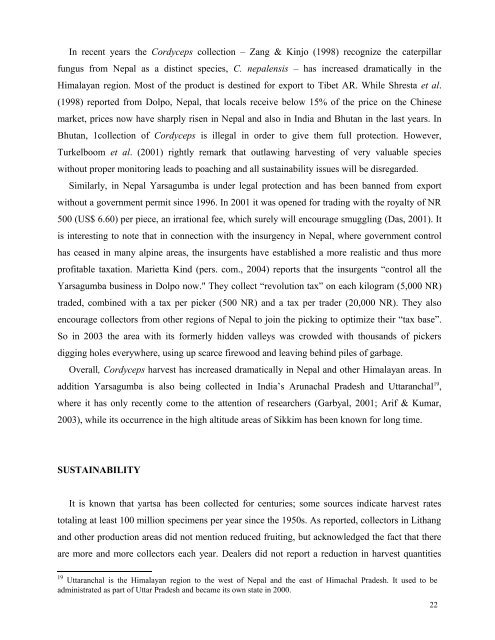Yartsa Gunbu - Cordyceps sinensis. Economy - Home
Yartsa Gunbu - Cordyceps sinensis. Economy - Home
Yartsa Gunbu - Cordyceps sinensis. Economy - Home
You also want an ePaper? Increase the reach of your titles
YUMPU automatically turns print PDFs into web optimized ePapers that Google loves.
In recent years the <strong>Cordyceps</strong> collection – Zang & Kinjo (1998) recognize the caterpillar<br />
fungus from Nepal as a distinct species, C. nepalensis – has increased dramatically in the<br />
Himalayan region. Most of the product is destined for export to Tibet AR. While Shresta et al.<br />
(1998) reported from Dolpo, Nepal, that locals receive below 15% of the price on the Chinese<br />
market, prices now have sharply risen in Nepal and also in India and Bhutan in the last years. In<br />
Bhutan, 1collection of <strong>Cordyceps</strong> is illegal in order to give them full protection. However,<br />
Turkelboom et al. (2001) rightly remark that outlawing harvesting of very valuable species<br />
without proper monitoring leads to poaching and all sustainability issues will be disregarded.<br />
Similarly, in Nepal Yarsagumba is under legal protection and has been banned from export<br />
without a government permit since 1996. In 2001 it was opened for trading with the royalty of NR<br />
500 (US$ 6.60) per piece, an irrational fee, which surely will encourage smuggling (Das, 2001). It<br />
is interesting to note that in connection with the insurgency in Nepal, where government control<br />
has ceased in many alpine areas, the insurgents have established a more realistic and thus more<br />
profitable taxation. Marietta Kind (pers. com., 2004) reports that the insurgents “control all the<br />
Yarsagumba business in Dolpo now." They collect “revolution tax” on each kilogram (5,000 NR)<br />
traded, combined with a tax per picker (500 NR) and a tax per trader (20,000 NR). They also<br />
encourage collectors from other regions of Nepal to join the picking to optimize their “tax base”.<br />
So in 2003 the area with its formerly hidden valleys was crowded with thousands of pickers<br />
digging holes everywhere, using up scarce firewood and leaving behind piles of garbage.<br />
Overall, <strong>Cordyceps</strong> harvest has increased dramatically in Nepal and other Himalayan areas. In<br />
addition Yarsagumba is also being collected in India’s Arunachal Pradesh and Uttaranchal 19 ,<br />
where it has only recently come to the attention of researchers (Garbyal, 2001; Arif & Kumar,<br />
2003), while its occurrence in the high altitude areas of Sikkim has been known for long time.<br />
SUSTAINABILITY<br />
It is known that yartsa has been collected for centuries; some sources indicate harvest rates<br />
totaling at least 100 million specimens per year since the 1950s. As reported, collectors in Lithang<br />
and other production areas did not mention reduced fruiting, but acknowledged the fact that there<br />
are more and more collectors each year. Dealers did not report a reduction in harvest quantities<br />
19 Uttaranchal is the Himalayan region to the west of Nepal and the east of Himachal Pradesh. It used to be<br />
administrated as part of Uttar Pradesh and became its own state in 2000.<br />
22


